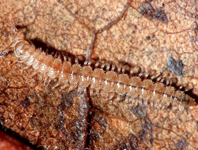Abstract
Three new genera, Retrorsioides, Rowlandesmus and Benedictesmus, are described and the polydesmid millipede fauna of North America is briefly reviewed with an emphasis on the genera Bidentogon Buckett & Gardner, 1968 and Retrorsia Shelley, 2003. Eighteen new species are described: Bidentogon buttensis, Bidentogon norcal, Retrorsia leonardi, Retrorsia benedictae, Retrorsia richarti, Retrorsia gracilis, Retrorsia simplicissima, Retrorsioides castellum, Retrorsioides linnensis, Retrorsioides kittitas, Retrorsioides bammerti, Retrorsioides arboramagna, Rowlandesmus millicoma, Rowlandesmus dentogonopus, Benedictesmus aureua, Benedictesmus ellenae, Benedictesmus yaquina and Benedictesmus timber. Natural history notes and illustrations are provided of putative commensal fungi, nematodes and a mite found on the millipede specimens.
References
Attems, C. (1894) Die Copulationfüsse der Polydesmiden. Sitzungberichten de kaiserliche Akademie der Wissenschaften in Wien, 103, 1–16.
Attems, C. (1940) Myriapoda 3. Polydesmoidea III. Das Tierreich, 70, 1–577.
Chamberlin, R.V. (1930) On some centipeds and millipeds from Utah and Arizona. The Pan-Pacific Entomologist, 6, 111–121.
Djursvoll, P. (2019) Two new species of Polydesmus Latreille, 1802/1803 from northern Spain with reinstatements of two species, and a key to the Iberian Polydesmus species (Diplopoda, Polydesmida, Polydesmidae). ZooKeys, 888, 51–65.
https://doi.org/10.3897/zookeys.888.37816
Enghoff, H. & Reboleira, A.S.P.S. (2017) Diversity of non–Laboulbenialean fungi on millipedes. Studies in Fungi, 2, 130–137.
https://doi.org/10.5943/sif/2/1/15
Enghoff, H., Golovatch, S.I., Short, M., Stoev, P. & Wesener, T. (2015) Diplopoda—taxonomic overview. In: Minelli, A. (Ed.), The Myriapoda. Vol. 2. Brill, Leiden, pp. 363–453.
https://doi.org/10.1163/9789004188273_017
Golovatch, S.I. (2013) A reclassification of the millipede superfamily Trichopolydesmidae, with descriptions of two new species from the Aegean region (Diplopod, Polydesmida). Zookeys, 340, 63–78.
https://doi.org/10.3897/zookeys.340.6295
Golovatch, S.I. (2014) Review of the millipede genus Epanerchodus Attems, 1901 in continental China, with descriptions of new species (Diplopoda, Polydesmidae). Zootaxa, 3760 (2), 275–288.
https://doi.org/10.11646/zootaxa.3760.2.7
Hoffman, R.L. (1950) Notes on some Virginia millipeds of the family Polydesmidae. The Virginia Journal of Science, 3, 219–225.
Hoffman, R.L. (1962) The milliped genus Scytonotus in eastern North America, with the description of two new species. The American Midland Naturalist, 67, 241–249.
https://doi.org/10.2307/2422832
Hoffman, R.L. (1974) A new polydesmid milliped from the southern Appalachians, with remarks on the status of Dixidesmus and a proposed terminology for polydesmid gonopods. Proceedings of the Biological Society of Washington, 87, 345–350.
Loomis, H.F. (1960) Millipeds of the Order Polydesmida from the western States and Baja California. Journal of the Kansas Entomological Society, 33, 57–68.
Loomis, H.F. (1972) Millipeds associated with ants in Washington state. The Florida Entomologist, 55, 145–151.
https://doi.org/10.2307/3493139
Mesibov, R. (2012) New species of Prosopodesmus Silvestri, 1910 (Diplopoda, Polydesmida, Haplodesmidae) from Queensland, Australia. ZooKeys, 190, 33–54.
https://doi.org/10.3897/zookeys.190.3276
Mikhaljova, E.V. (2005) New data on the millipede fauna of the basin of Amur River (Diplopoda). Arthropoda Selecta, 14, 129–132.
Olsen, S.A., Rosenmejer, T. & Enghoff, H. (2020) A mountain of millipedes IX: Species of the family Gomphodesmidae from the Undzungwa Mountains, Tazania (Diplopod, Polydesmida). European Journal of Taxonomy, 675, 1–35.
https://doi.org/10.5852/ejt.2020.675
Petit, G., (1976) Développements comparés des appendices copulateurs (gonopodes) chez Poly- desmus angustus Latzel et Brachydesmus superus Latzel (Diplopodes: Polydesmidae). International Journal of Insect Morphology and Embryology, 5, 261–272.
https://doi.org/10.1016/0020-7322(76)90026-X
Rodriguez, J., Jones, T.H., Sierwald, P., Marek, P.E., Shear, W.A., Brewer, M.S., Kocot, J.E. & Bond, J.E. (2018) Step-wise evolution of complex chemical defenses in millipedes: a phylogenomics approach. Scientific Reports, 8, 3209.
https://doi.org/10.1038/s41598-018-19996-6
Shear, W.A. (1972) The milliped genus Bidentogon (Diplopoda, Polydesmida, Trichopolydesmidae). Proceedings of the Biological Society of Washington, 85, 489–492.
Shear, W.A. (2012) Snoqualmia, a new polydesmid milliped genus from the northwestern United States, with a description of two new species (Diplopoda, Polydesmida, Polydesmidae). Insecta Mundi, 0238, 1–13.
Shear, W.A. & Shelley, R.M. (2007) The milliped genus Tidesmus Chamberlin, 1943 (Polydesmida: Macrosternodesmidae. Zootaxa, 1656, 51–68.
https://doi.org/10.11646/zootaxa.1656.1.2
Shelley, R.M. & Golovatch, S.I. (2000) The milliped family Haplodesmidae in the Hawaiian Islands,with records of Prosopodesmus jacobsoni from Florida and Louisiana (Diplopoda: Polydesmida). Bishop Museum Occasional Papers, 64, 48–49.
Shelley, R.M. (1993) Revision of the milliped genus Scytonotus Koch (Polydesmida: Polydesmidae). Brimleyana, 19, 1–60.
Shelley, R.M. (1994) The millipede family Nearctodesmidae in northwestern North America, with accounts of Sakophallus and S. simplex Chamberlin (Polydesmida) Canadian Journal of Zoology, 72, 470–495.
https://doi.org/10.1139/z94-066
Shelley, R.M. (1996a) The milliped genus Utadesmus Chamberlin & Hoffman (Polydesmida: Polydesmidae. Myriapodologica, 4, 9–16.
Shelley, R.M. (1996b) The identity of Alpertia latifrons Loomis, with records of introduced polydesmids from northwestern North America, deletion of Polydesmus racovitzai Brolemann, and identification of invalid taxa (Polydesmida: Polydesmidae). Myriapodologica, 4, 17–20.
Shelley, R.M. (1997) The identity of Polydesmus sastianus Chamberlin, proposal of a new milliped genus, and remarks on the identity of Phreatodesmus hastingsus (Chamberlin) (Polydesmida: Polydesmidae). Myriapodologica, 4, 59–67.
Shelley, R.M. (2003) A new polydesmid genus and two new species from Oregon and Washington, U. S. A., with a review of Bidentogon Buckett & Gardner, 1968, and a summary of the family in western North America (Polydesmida: Polydesmidae). Zootaxa, 296 (1), 1–12.
https://doi.org/10.11646/zootaxa.296.1.1
Sierwald, P., Hennen, D.A., Zahnle, X.J., Ware, S. & Marek, P.E. (2019) Taxonomic synthesis of the eastern North American millipede genus Pseudopolydesmus (Diplopoda: Polydesmida: Polydesmidae), utilizing high-detail ultraviolet fluorescence imaging. Zoological Journal of the Linnean Society, 20, 1–26.
https://doi.org/10.1093/zoolinnean/zlz020
Simonsen, Å. (1990) Phylogeny and biogeography of the millipede order Polydesmida, with special emphasis on the suborder Polydesmidea. Doctoral dissertation, Museum of Zoology, University of Bergen, Bergen, 114S.
Spelda, J., Golovatch, S.I. & Meidell, B. (1998) Revision of the Central Asian millipede genus Turanodesmus Lohmander, 1932 (Diplopoda, Polydesmidae). Arthropoda Selecta, 7, 163–174.
Tanabe, T. & Sota, T. (2008) Complex copulatory behavior and the proximate effect of genital and body size differences on mechanical reproductive isolation in the millipede genus Parafontaria. The American Naturalist, 171 (5), 692–699.
https://doi.org/10.1086/587075
Wojcieszek, J.M., Austin, P., Harvey, M.S. & Simmons, L.W. (2012) Micro-CT scanning provides insight into the functional morphology of millipede genitalia. Journal of Zoology, 287, 91–95.
https://doi.org/10.1111/j.1469-7998.2011.00892.x
Wojcieszek, J.M. & Simmons, L.W. (2013) Divergence in genital morphology may contribute to mechanical reproductive isolation in a millipede. Ecology and Evolution, 3, 334–343.
https://doi.org/10.1002/ece3.466
Zahnle, X.J., Sierwald, P., Ware, S. & Bond, J.E. (2020) Genital morphology and the mechanics of copulation in the millipede genus Pseudopolydesmus (Diplopoda: Polydesmida: Polydesmidae). Arthropod Structure and Development, 54, 1–19.
https://doi.org/10.1016/j.asd.2020.100913


